nScrypt Demonstrates Ability to 3D Print Embedded Sensors for Medical Devices
nScrypt, a manufacturer of industrial 3D printers and bioprinting tools, has announced the ability to 3D print medical implants with embedded circuits and sensors. The goal of the technology is to be able to monitor the health of both the device and the patient.
Florida-based nScrypt is a unique company, in that it has developed a range of industrial 3D printing and bioprinting technology capable of fabricating parts with very specific applications. For instance, the firm has developed tools such as a microdispensing SmartPump, as well as a high precision pick-and-place system with ≤2 micron repeatability. nScrypt’s 3Dn Bio Assembly Tools will even be used in 2019 on the International Space Station, where they will be used to print beating heart patches.
 Strain gauge conformally printed onto the side of a printed PAPC cylinder. (Left image courtesy of FibreTuff, right image courtesy of nScrypt.)
Strain gauge conformally printed onto the side of a printed PAPC cylinder. (Left image courtesy of FibreTuff, right image courtesy of nScrypt.)
For this latest achievement, nScrypt has relied on a polyamide polyolefin and cellulose (PAPC) compound, developed by FibreTuff Medical Biopolymers, that uses FDA-compliant ingredients. The material is meant to be a cost-effective alternative to polyether ether ketone, an industrial plastic known for its many useful physical properties, including strength, heat resistance and biocompatibility.
FibreTuff’s PAPC materials provide part strength, layer adhesion and the ability to adhere to specialized coatings. This last feature makes it possible for circuits to be placed on or embedded within PAPC parts, so that sensors can be attached to monitor the health of the part or its surrounding environment. As a result, this process is ideal for 3D printing medical devices or implants so that the embedded sensor can track the health of the part or patient.
“nScrypt is a leader and pioneer in both 3D-printed electronics and bioprinting,” nScrypt CEO Ken Church said. “It is a natural fit and progression for us to continue work on applications which bring together these technologies. Lower cost, better performing materials are important for next-generation biomedical devices. The ability to 3D print these types of materials decreases time for manufacturing and provides a custom attribute that will improve performance.”
nScrypt’s machines have been designed for 3D printing circuits on non-planar surfaces through the use of a laser height sensor for scanning the surface before extruding conductive material or placing components using the technology mentioned above, such as microdispensing and pick-and-place toolheads. To demonstrate the possibilities, nScrypt 3D printed a strain gauge onto a cylinder made from PAPC.
Source: Engineering.com




Recent Comments